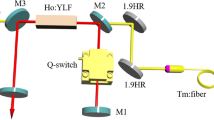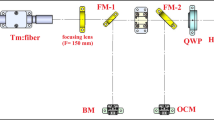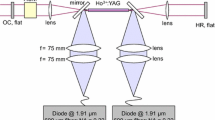Abstract
We describe an efficient, low-threshold, continuous-wave (CW) and Q-switched operation of a Ho:YAG laser resonantly, single-pass pumped by a 20 W linearly polarized narrow line width Tm: fiber laser at the wavelength of 1,908 nm. At room temperature for an output coupler of 30 % transmission, a maximum continuous-wave output power of 13.3 W for 18.9 W of absorbed pump power was achieved, corresponding to a slope efficiency of 73 %. In a quasi continuous-wave pumping regime, for several output couplers slope efficiencies of almost 82 % were observed. For a Q-switched operation, a Brewster-cut acousto-optic modulator was used. In a CW pumping regime, the pulse repetition frequency (PRF) was changed from 4 to 15 kHz. Under a Q-switched operation, the maximum output power of 12.25 W in relation to 15 kHz PRF was obtained; however, the maximum peak power of almost 250 kW at the PRF of 4 kHz was demonstrated. In the best case, for 4 kHz PRF, pulse energies of 2.18 mJ with a 8.8 ns FWHM pulse width (one of the shortest pulse durations observed in holmium-doped Q-switched lasers) were achieved. The laser operated at the wavelength of 2,090.23 nm with the FWHM line width of 0.95 nm. The beam quality factor of M 2 was measured to be below 1.42 in both X and Y axis.
Similar content being viewed by others
Avoid common mistakes on your manuscript.
1 Introduction
The near- and mid-infrared range covering the spectral band of 1–12 μm has been the one of the most explored research regions in laser technology in recent years [1]. The interest in this area results from the fact that the environment monitoring and national security engineering utilize radiation of this particular wavelength range—mainly due to an occurrence of spectral lines—characteristic for many chemical and biological compounds. The use of pulsed lasers delivering radiation at a wavelength fitted to particular absorption lines is the necessity, e.g., in contamination detection and recognition or the evaluation of atmosphere composition.
Compact, high-peak and average-power laser sources operating in the mid-infrared spectral range, due to low attenuation in the atmosphere and ‘eye-safety’ aspects, are very useful for a variety of scientific and technical applications. They are required for remote sensing [2] and the monitoring of atmospheric CO2 and H2O [3, 4], wind measurements, as well as for long distance range finders. They offer unique and exceptional properties which are required in such applications as material processing or laser surgery and therapy [5–7]. Additionally, by tuning a laser across the 2-μm spectral region, the water absorption can be changed by an order of magnitude, and this can bring additional and exploitable advantages for laser surgery and related applications. In such applications, bulk lasers utilizing thulium (Tm3+) and holmium (Ho3+) co-doped materials [8, 9], diode-pumped thulium-doped bulk [10] and fiber lasers [11], holmium lasers pumped by diode-pumped thulium lasers [12, 13], and hybrid-type lasers [14] are commonly used. It is worth mentioning that supercontinuum (SC) fiber-based generators have also been treated as an attractive source of mid-infrared radiation [15], especially as they can provide over an octave-spanning spectrum of output laser beam with only diffraction-limited quality. However, owing to the low spectral density (usually <10 mW/nm) of output beam, application possibilities of SC generators are limited.
In recent years, high efficiency Ho oscillators in different configurations based on several hosts as YAG [16, 17], YLF [18, 19], YAP [20], LuAG [21], LLF [22], LSO [23], ceramic [24], and silica fiber [25, 26] have been developed and reported. If we are talking about Ho:YAG lasers, it seems that diode-pumped Tm-doped bulk lasers [27, 28] and Tm-doped fiber lasers [29] seem to be the most attractive sources for direct pumping. However, recently, an efficient high-power Ho:YAG laser directly in-band pumped by a laser diode stack at 1.9 μm was demonstrated [30]. In a hybrid laser configuration, a Tm-doped fiber laser is used as a pump source, playing the role of an almost ideal source of energy for ‘in-band’ resonantly pumping the upper laser level of a gain medium. The resonantly pumped Ho lasers benefit of very high efficiencies due to a very low quantum defect, excellent mode matching (because of the high quality of the pumping beam), compactness and modularity of the optical scheme, and last but not least the commercial availability of pump sources. As a result, hybrid lasers are efficient and immune to thermal effects and, what is more important, they are capable of generating highly energetic pulses of optical radiation. Fiber, bulk, hybrid holmium lasers are one of the most explored constructions of this type, which have been proved by many efficient demonstrations widely described in [31]. There is no doubt that the future of photonics and laser technology will be connected with such lasers and their progress, to a large extent, depending on the demand for particular technological and construction solutions. Hybrid holmium laser systems would constitute a unique and irreplaceable source for further works carried out within laser technology. Moreover, tuneable 2-μm lasers can be suitable pump sources for optical parametric oscillators based on ZnGeP2 (ZGP), GaAs crystals, which also constitute a novelty in the area of lasers operating at longer wavelengths (3–12 μm) [32, 33].
2 Experimental arrangement
A Ho:YAG laser was developed according to the conception depicted in Fig. 1. The pumping was realized by a single 20-W linearly polarized Tm: fiber laser made by IPG Photonics (model TLR-20-1908-LP) operating at the wavelength of 1,908 nm with the line width of 0.4 nm (FWHM). The pump radiation was delivered to a Ho:YAG crystal by the output facet of the collimator. The collimated beam diameter and divergence angle were 4.2 mm and 0.6 mrad, respectively. The beam quality factor M 2 was 1.05.
The 1 % Ho:YAG rod of 4-mm in diameter and 20-mm in length was used as an active medium. The end facets were anti-reflection coated for the 1,850–2,100 nm wavelength range. The crystal was wrapped with an indium foil and mounted in a water-cooled copper heat-sink. In this experiment, the temperature of the Ho:YAG crystal was held at 17 °C. The measured fluorescence upper laser level lifetime (5I7) was 8.37 ms. The same cooling system was applied to an acousto-optic modulator. The pump radiation was focused inside the Ho:YAG crystal by a plano-convex spherical lens f with AR broadband coating. The Ho:YAG crystal was positioned in the vicinity of a flat dichroic mirror DM with high reflectivity in the 2,000–2,200 nm wavelength band and high transmission (T > 96.5 %) at the pump wavelength, inside a plano-concave resonator. A Brewster-cut acousto-optic modulator manufactured by Gooch and Housego was used for Q-switched operation. In order to separate unabsorbed pump power from the holmium wavelength, the transmitted pump light was extracted with the use of the dichroic mirror M, a little tilted to the optical axis.
One of the most important parameters affecting the efficient generation in axially pumped solid state lasers is the overlap efficiency defined as the ratio of resonator mode volume and the active medium pumped volume. In order to match the pump laser beam diameter to the diameter of the laser mode in the resonator, the pump beam spatial distribution was measured in the dependence on focal length of the collimating lens f. The caustics of the pump laser beam were measured using lenses with various focal lengths. The general assumption of the laser construction was that the length of the resonator should be long enough to place acousto-optic modulator of the length of l = 35 mm and matching caustic of the pumping beam to the laser mode in the resonator. Given the intended design into consideration, the numerical study of the laser mode distribution in the cavity, depending on the geometry of the resonator and used elements, was carried out. The results of both measurement and numerical analysis showed that in order to optimize the pumping energy transfer into the active medium, a collimating lens of a focal length of f = 400 mm and the Ho:YAG laser output mirror with a curvature radius of R OC = 100 mm should be used.
3 Free-running experiments
The laser energetic characteristics were measured in a free-running mode of operation in a cavity without an acousto-optic modulator (AOM) in the dependence on the output coupler transmittance. Three different transmissions of the output coupler T OC (T Ho1 = 10 %, T Ho3 = 30 %, T Ho4 = 40 % at 2,090 nm) were investigated. In a quasi continuous-wave (qCW) pumping regime with the repetition rate of 20 Hz and 8 ms pulse width (16 % duty factor DF), the results obtained are presented in Fig. 2. The highest slope efficiency value of 82 % was obtained at an output coupling of T OC = 30 %. Thus, the same output coupler transmission (curvature radius R OC = 100 mm) was used in the CW operation. For the maximum available pump power in the CW regime, 13.3 W of the laser output power with a slope efficiency of 73 % with respect to absorbed pump power was demonstrated (Fig. 3). To additionally optimize the best output values, the length of the resonator and distance from the collimating lens f to crystal Ho:YAG were adjusted. The physical length of the resonator was about 100 mm.
4 Q-switching experiments
In Q-switching regime a fused silica 35-mm-long conduction cooled Brewster-cut acousto-optic modulator was inserted into the cavity. It was mounted near the active medium and driven by a 20 W RF power at 40.68 MHz. The modulating signal was synchronized with the external generator. The laser output characteristics were performed versus the absorbed pump power for various PRFs. The results of the Q-switching experiments for the CW pumping regime for an output coupler transmittance of T OC = 30 % are shown in Fig. 4.
The best results for the maximum available pump power are listed in Table 1 and presented in Fig. 5. The pulse repetition frequency was varied from 4 to 15 kHz. For the minimum PRF, pulses of almost 2.2 mJ energy were achieved. For the maximum incident pump power of 19.69 W, for PRF of 15 kHz, the highest average output power of 12.25 W was measured corresponding to optical-to-optical conversion efficiency of 62 %. A > 12.5 GHz high-speed detector with a rise/fall time of 28 ps made by Electro-Optics Technology (ET-5000) was used to measure the 2-μm laser output pulses. The shortest pulses of 8.8 ns FWHM length and almost 250 kW peak power were achieved for the 4 kHz PRF. The scope of one of the shortest recorded pulses is presented in Fig. 6.
For the Q-switched Ho:YAG laser, spectroscopic and spatial distribution measurements of the laser beam were undertaken. In order to determine the beam quality factor (M 2), a high-power NanoScan pyroelectric detector made by Photon was used. Figure 7 shows the measured beam radius of the Ho:YAG laser at different distances after passing through a focusing lens of 250-mm focal length. Solid symbols represent data taken from the instrument. Solid curves are fitted to a Gaussian beam-standard expression. The beam quality factors of M 2 at the 5 kHz PRF were measured on an X and Y axis (Fig. 7), and they were estimated at M 2 x = 1.42 and M 2 y = 1.29, respectively. The mode profile of the Ho:YAG laser was recorded with a pyroelectric NanoScan—scanning-slit laser beam profiler. A nearly perfect Gaussian beam profile inside the resonator within the whole scan results from the single-mode pump laser was created, and it is shown in a 3D dimension inserted in Fig. 7. The wavelength of the Ho:YAG laser was measured with the use of an AQ6375 optical spectrum analyzer made by Yokogawa with a resolution of 1 nm. The laser operated at the wavelength of λ = 2,090.23 nm with the FWHM Δλ = 0.96 nm (Fig. 8).
5 Conclusions
An efficient and compact Q-switched Ho:YAG laser based on a commercially available thulium-doped fiber laser, with the maximum peak power of almost 250 kW, was demonstrated. This laser was experimentally optimized to minimize the power threshold. The output power in the CW regime of 13.3 W with a 73 % slope efficiency with respect to absorbed pump power was limited by the available pump power. The lasing threshold of only 0.3 W of incident pump power was calculated. Using the fiber laser to end pump a Q-switched Ho:YAG laser, the average output power of 12.25 W at a 15 kHz pulse repetition frequency and pulse energies of 2.18 mJ with a 8.8 ns FWHM pulse width at a 4 kHz PRF with M 2 < 1.42 were obtained. The scaling up to higher output powers can be achieved by increasing absorption efficiency—that is by pump power recycling and mode-matching efficiency optimization and by using a more powerful fiber laser also. The output parameters of the developed Ho:YAG laser are satisfactory for the effective pumping of ZGP OPOs operating in the mid-infrared range.
References
A. Godard, C.R. Physique 8, 1100 (2007)
Y. Bai, J. Yu, P. Petzar, M. Petros, S. Chen, B. Trieu, H. Lee, U. Singh, in Technical Digest Conference on Lasers and Electro-Optics, paper CWH5 (2009)
K. Scholle, E. Heumann, G. Huber, Laser Phys. Lett. 1, 285 (2004)
T.M. Taczak, D.K. Killinger, Appl. Opt. 37, 8460 (1998)
A.S. Knipper, A.J. Gross, Urolithiasis 481 (2012)
N.M. Fried, B.R. Matlaga, Laser Dermatol. Med. 561 (2012)
M. Binbay, A. Tepeler, A. Singh, T. Akman, E. Tekinaslan, O. Sarilar, M. Baykal, A.Y. Muslumanoglu, Int. Urol. Nephrol. 43, 989 (2011)
A.A. Lagatsky, F. Fusari, S.V. Kurilchik, V.E. Kisel, A.S. Yasukevich, N.V. Kuleshov, A.A. Pavlyuk, C.T.A. Brown, W. Sibbett, Appl. Phys. B 97, 321 (2009)
F. Chen, L.X. Yu, X.L. Liu, B.Q. Yao, W. Wang, C.H. Zhang, Y.L. Ju, Laser Phys. 22, 367 (2012)
Y.L. Ju, X.D. He, B.Q. Yao, G.L. Zhu, X.M. Duan, Y.Z. Wang, Laser Phys. 21, 2025 (2011)
J. Swiderski, M. Maciejewska, J. Kwiatkowski, M. Mamajek, Laser Phys. Lett. 10, 015107 (2013)
S. So, J.I. Mackenzie, D.P. Shepherd, W.A. Clarkson, Proc. SPIE 6871, 68710R (2008)
Y.J. Shen, B.Q. Yao, X.M. Duan, T.Y. Dai, Y.L. Ju, Y.Z. Wang, Appl. Opt. 51, 7887 (2012)
W.A. Clarkson, D. Shen, J.K. Sahu, Proc. SPIE 6100, 61000A-1 (2006)
J. Swiderski, M. Maciejewska, Appl. Phys. B 109, 177 (2012)
M. Schellhorn, Appl. Phys. B 85, 549 (2006)
G. Renz, M. Klose, C. Reiter, F. Massmannand, H. Voss, in Advanced Solid-State Photonics, paper WD3 (OSA 2006)
W. Koen, C. Bollig, H. Strauss, M. Schellhorn, C. Jacobs, M.J.D. Esser, Appl. Phys. B 99, 101 (2010)
M. Schellhorn, Appl. Phys. B 103, 777 (2011)
Y.J. Zhang, G. Li, Y.Y. Zhao, Y.N. Chen, Laser Phys. 22, 415 (2012)
H. Chen, D.Y. Shen, X.D. Xu, T. Zhao, X.F. Yang, D.H. Zhou, J. Xu, Laser Phys. Lett. 9, 26 (2012)
J.W. Kim, J.I. Mackenzie, D. Parisi, S. Veronesi, M. Tonelli, W.A. Clarkson, Opt. Lett. 35, 420 (2010)
B.Q. Yao, X.M. Duan, Y.L. Ju, Y.Z. Wang, Laser Phys. 21, 1888 (2011)
X.J. Cheng, J.Q. Xu, M.J. Wang, B.X. Jiang, W.X. Zhang, Y.B. Pan, Laser Phys. Lett. 7, 351 (2010)
A.S. Kurkov, V.A. Kamynin, E.M. Sholokhov, A.V. Marakulin, Laser Phys. Lett. 8, 754 (2011)
S.D. Jackson, A. Sabella, D.G. Lancaster, IEEE J. Sel. Top. Quantum Electron. 13, 567 (2007)
P.A. Budni, M.L. Lemons, J.R. Mosto, E.P. Chicklis, IEEE J. Sel. Top. Quantum Electron. 6, 629 (2000)
N.G. Zakharov, O.L. Antipov, V.V. Sharkov, A.P. Savikin, Quantum Electron. 40, 98 (2010)
E. Lippert, S. Nicolas, G. Arisholm, K. Stenersen, G. Rustad, Appl. Opt. 45, 3839 (2006)
S. Lamrini, P. Koopmann, M. Schäfer, K. Scholle, P. Fuhrberg, Appl. Phys. B 106, 315 (2012)
M. Eichhorn, Appl. Phys. B 93, 269 (2008)
C. Kieleck, M. Eichhorn, A. Hirth, Ann. Phys. Fr. 32, 79 (2007)
C. Kieleck, M. Eichhorn, A. Hirth, D. Faye, E Lallier. Opt. Lett. 34, 262 (2009)
Acknowledgments
This research has been co-financed by European Union resources under the National Strategic Reference Framework (Innovative Economy Programme No. WND-POIG.02.01.00-14-095/09) and from the National Science Centre under project No. 2011/03/B/ST7/00256.
Author information
Authors and Affiliations
Corresponding author
Rights and permissions
Open Access This article is distributed under the terms of the Creative Commons Attribution License which permits any use, distribution, and reproduction in any medium, provided the original author(s) and the source are credited.
About this article
Cite this article
Kwiatkowski, J., Jabczynski, J.K., Zendzian, W. et al. High repetition rate, Q-switched Ho:YAG laser resonantly pumped by a 20 W linearly polarized Tm: fiber laser. Appl. Phys. B 114, 395–399 (2014). https://doi.org/10.1007/s00340-013-5532-0
Received:
Accepted:
Published:
Issue Date:
DOI: https://doi.org/10.1007/s00340-013-5532-0












